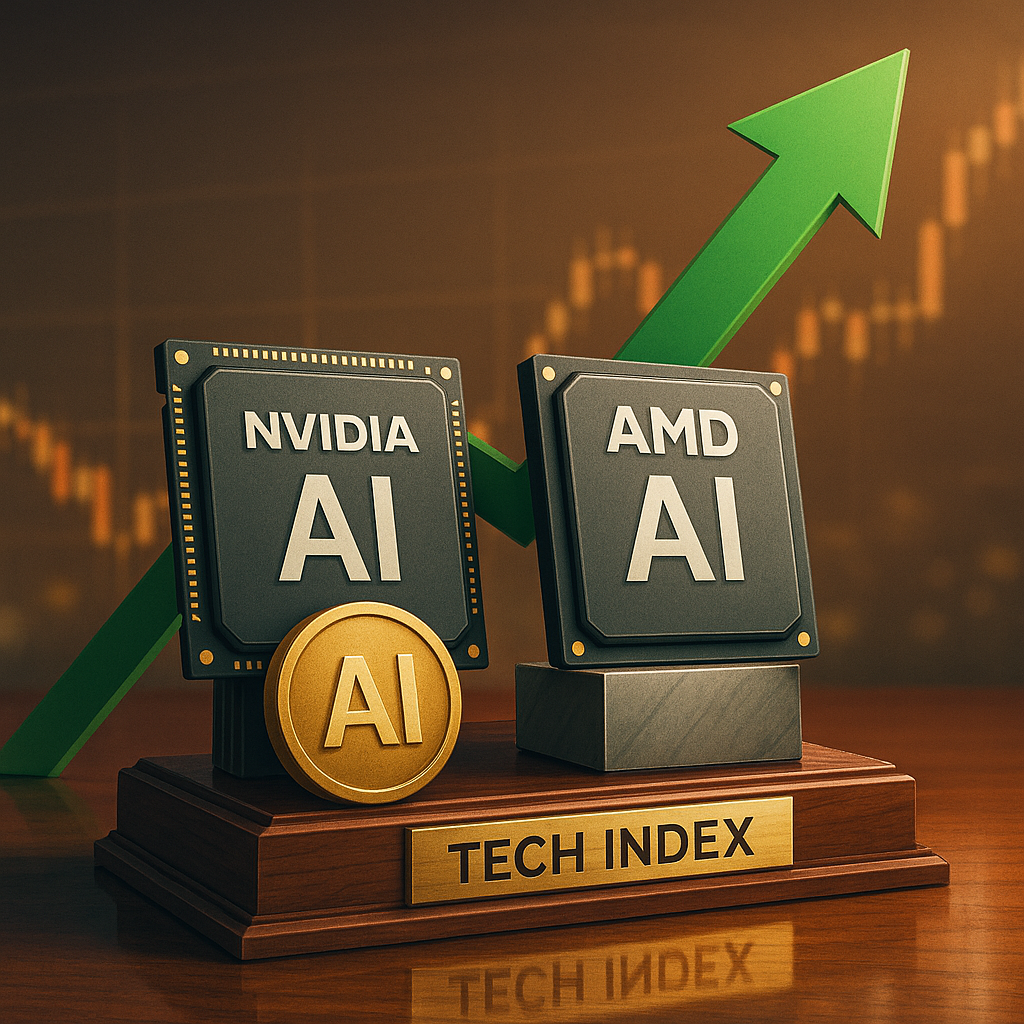The recent AI chip surge has pushed the Nasdaq-100 Technology Index to a fresh peak. Nvidia and AMD posted strong results, beating Wall Street forecasts by wide margins. Investors now ask what this means for chip equipment firms, memory makers, and other suppliers.

Earnings Beat Sparks Broad Tech Rally
Nvidia’s April–June revenue climbed 78 % to $39.3 billion, topping even upbeat estimates. EPS more than doubled. AMD also beat, reporting $9.2 billion in sales—15 % above consensus. Both stocks gained over 5 % in after-hours trade. The index, fueled by the AI chip surge, rose 4 % the next day, its best single-day jump this year. Optimism from the AI chip boom spilled into cloud, software, and data-center names as well.
Inside the Index: Weight and Impact
Nvidia now holds about 5 % of the Nasdaq-100 Technology Index. AMD owns nearly 3 %. When these two move together, they can swing the whole gauge by half a percent. Apple, Microsoft, and Alphabet still anchor the benchmark, yet their share slipped a bit because of the chip rally. The index’s top ten now include three pure-play semiconductor firms—a rare mix that shows how fast AI demand is shaping market structure and has led to a surge in chip stock interest.
AI Chip Surge Boosts Supply Chain
Supplier stocks jumped too. ASML rose 7 % after reporting record EUV tool orders. Applied Materials and Lam Research each advanced over 6 %. Memory makers SK Hynix and Micron saw double-digit weekly gains. Analysts raised 2025 earnings forecasts for equipment firms by 8–10 %. Capital-spending guides from cloud giants back these upgrades: Amazon, Alphabet, and Meta all plan larger AI budgets, influenced by the new surge in chip demand.
Key Suppliers Poised to Gain from the AI Chip Surge
- ASML: Bookings suggest a tight backlog through 2027.
- Lam Research: Predicts 20 % revenue growth on new etch tools.
- Micron: Sees AI-grade HBM memory lifting margins next year.
Many expect the supply chain to remain tight. Lead times for top-end chips still sit near 30 weeks, though they have improved from the 40-week peak last year due to the surge in AI chip interest.
Risks and Next Catalysts
Higher rates remain a headwind. Ten-year Treasury yields touched 4.5 %, which can drag on high-multiple tech shares. Export controls add another risk: new U.S. rules could curb advanced GPU sales to China. Yet demand elsewhere may fill the gap if that happens. Investors are still watching the market closely amidst the AI chip surge, with an eye on potential risks.
Key near-term events:
- Nvidia’s product-launch event next quarter.
- Taiwan Semiconductor’s capacity update.
- September inflation data that may shift rate expectations.
Any sign of weaker AI spending could cool sentiment. Still, most analysts see double-digit chip revenue growth into 2026, driven by ongoing chip advances.
Portfolio Moves to Watch
ETF flows tell the story. Over the past three weeks, AI-focused funds attracted $1.3 billion in net inflows. Broader tech ETFs gained $900 million. At the same time, defensive sectors lost cash. Some managers are trimming cloud names to fund chip positions, betting on continued upside but hedging with put spreads in case yields jump again.
Investors looking to capitalize on the ongoing AI chip surge should watch valuations. Nvidia trades near 27 times forward earnings, above its five-year average but still below the 2021 peak. Equipment makers carry lower multiples, offering a possible value angle. Memory firms could benefit next if capacity shortages widen.